Located halfway between Phnom Penh and the southern coast, Kampot is Cambodia’s capital of riverside relaxation. Use my bumper list of things to do in Kampot to plan your trip.
I’ve been to Kampot more times than I can count. When I lived in Phnom Penh, it was my regular long-weekend retreat. Whenever I go back to Cambodia, it’s always at the top of my list of places to revisit, right alongside Kampong Cham.
Kampot is clean, green, and brimming with beautiful French architecture. The city centre runs along a languid river, setting the tone for a laid-back pace of life.
But it’s not all about lounging and sipping Kampot cider in your bungalow – there are lots of things to do in Kampot to keep you busy. Whether you’re into outdoor adventure, art, or you like the sound of eating and drinking your way around one of Cambodia’s best destinations for foodies, Kampot has something for you.
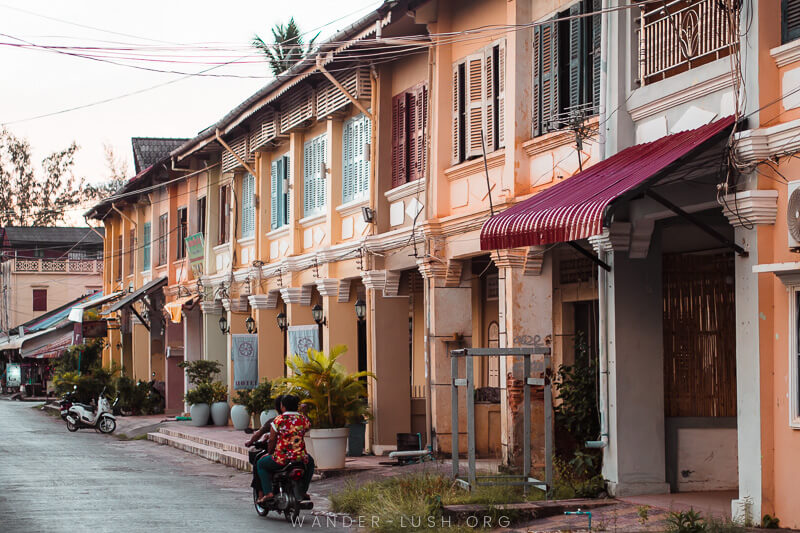
Welcome to Kampot
Need a place to stay? Check out my comprehensive Kampot accommodation guide for all budgets.
Kampot is built up around the life-giving Praek Tuek Chhu river, which is the centrepiece of Kampot town. Compared with the Mekong or Tonle Sap, it’s a relatively clean waterway that’s safe to swim in (the further you go out of town, the better the water quality).
A wide, flower-lined promenade traces the river’s east bank along the edge of town, framing picturesque vistas of a distant Bokor National Park and flanking Kampot’s crop of riverside bars, hotels and boutiques.
Push just a few streets deeper from the riverfront and you’ll discover Kampot town proper, with its charming shop houses, old colonial villas and open boulevards.
Crowded with beautiful facades and leafy nooks, Kampot is best explored on foot or by bicycle – but if you’re staying at one of the popular resorts nestled in the jungle north of town, you will need to hire a scooter or find a tuk tuk to take you around.
As well as the best things to do in Kampot, this Kampot guide covers all the practical information you’ll need to plan the perfect trip.
Please note: This post contains affiliate links, meaning I may earn a commission if you make a purchase by clicking a link (at no extra cost to you). Learn more.
Planning your trip to Kampot
First things first, here are a few essential things to know when planning a trip to Kampot.
When to visit Kampot
Kampot’s high season is during the winter months (November-January). This is a pleasant time temperature wise, but it’s busier and more expensive than usual. March-May is the hottest time of the year and should be avoided. The monsoon season hits mid-year and brings heavy rain and afternoon storms.
The best time to visit Kampot is during shoulder season after the monsoon (September-October), when the rice fields are green, temperatures are cool, and it’s less crowded.

Where to stay in Kampot
- Budget: Mad Monkey Hostel offers mixed and single-sex dorms, outdoor common spaces, and a revolving program of tours and activities.
- Mid-range: MAKK Hotel is conveniently located in town. The upstairs rooms open onto a breezy balcony where breakfast is served each morning. Staff here are delightful. There are free bicycles for guests.
- Boutique: Set in a restored heritage movie house, Hotel Old Cinema is one of Cambodia’s coolest boutique hotels. Read my full write-up here.
- Luxury: Kampot River Residence features well-appointed bungalows decorated in traditional Khmer style.
- Riverside bungalows: Samon Village is a family owned homestay-style accommodation on the opposite side of the river. Bungalows look out on the water, and there’s a large garden. Perfect for families.
Check out my comprehensive Kampot hotel guide for more inspiration, or browse all Kampot accommodation options on Agoda.
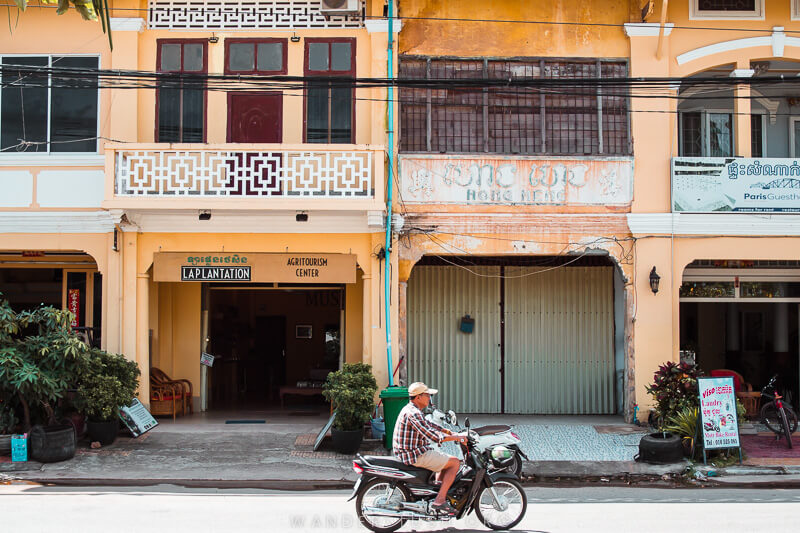
How to get to Kampot
- From Phnom Penh: Giant Ibis bus (4 hrs; $10; online tickets here); Kampot Express van (3 hrs; $8; online tickets here) or train (5 hrs; $7; Friday-Sunday only; tickets here).
- From Sihanoukville: Champa Tourist bus (2 hrs; $6; online tickets here).
- From Siem Reap: Giant Ibis bus via Phnom Penh (15 hrs; $20; online tickets here).
Do you need a visa for Cambodia?
Most nationalities require a tourist visa to visit Cambodia for 30 days. Use the iVisa website to see if you need a visa, and to apply and pay for an expedited visa online.
41 Wonderful Things to Do in Kampot
Here are my absolute favourite things to do in Kampot, organised by genre and location.
Things to do in Kampot town
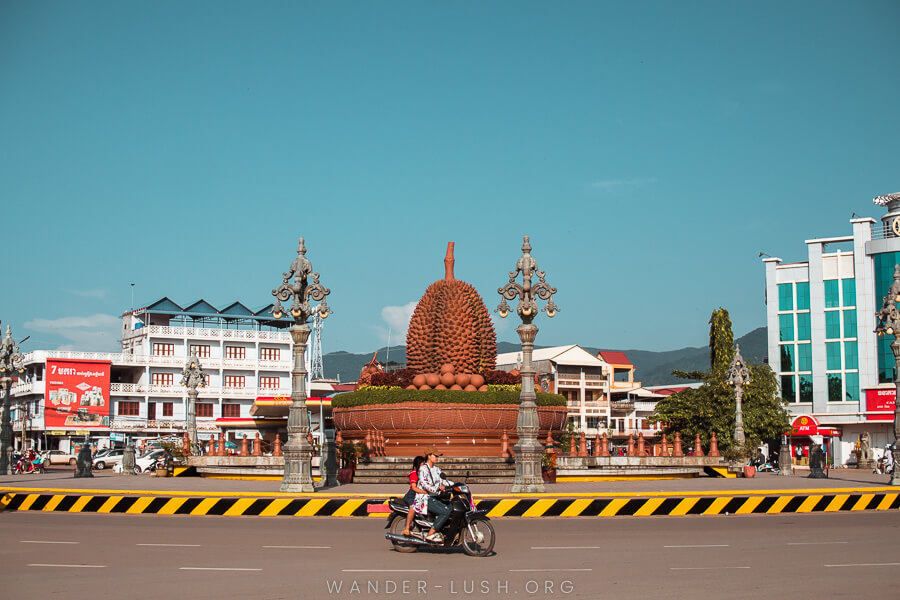
Take a spin around the Durian Roundabout
This may seem like a funny place to start, but the Durian Roundabout is Kampot’s most recognisable landmark. As the name suggests, it features a prominent sculpture of an oversized durian in the centre. Durian is a wildly popular fruit in Southeast and East Asia – if you’ve never tasted it (or at least smelt it), it’s a bit like overripe, stinky mango. The quirky traffic circle pays homage to Kampot’s days as a centre of durian production in the 1940s.
If you’re arriving in Kampot by bus or van, you’ll likely get dropped off near the roundabout. You can use it to get your bearings. Kampot Night Market branches off from the northern side. Take any of the streets south to reach the Old Market and main part of town. Walk east from the roundabout and you’ll soon get a glimpse of the Praek Tuek Chhu and Kampot’s beautiful riverside district.

Explore Old Market Street
Old Market Street bisects downtown Kampot into two halves, with the famous Durian Roundabout to the north, and the slightly-less-naff Saltworkers Roundabout to the south. Although the Old Market building itself is derelict, the street serves as Kampot’s main drag and is home to a handful of popular cafes and gift shops.
Chinese shophouses (with a spattering of 19th-century French architecture thrown in) dominate the skyline in Kampot, once a regional administrative capital and formerly Cambodia’s most important sea port. Many original buildings still line the streets – made all the more interesting by decades of ad-hoc additions and half-finished renovations.
A few buildings have been resurrected with a lick of brightly coloured paint, while other street-facing facades sit in various states of disrepair and decay.

Visit the Kampot Fish Market
Built in 1934, Kampot Fish Market once served as an open-air marketplace for the area’s fishermen to sell their catch of the day. (A similar market, the Crab Market, still exists in nearby Kep.) It later became a discotheque. When an Australian restaurateur bought the property in 2013, he went about restoring the building to its former Art Deco glory.
The result is stunning. The open facade has been preserved and painted a striking shade of Indochina yellow. Under vaulted ceilings, an upmarket restaurant serves locally caught seafood. The dining room backs directly onto the river, and there is a large outdoor terrace to sit and watch the sun go down. Some of the interior walls are decorated with murals by the same local artists who illustrated The Balé hotel in Phnom Penh and created many of the capital’s street murals.
Even if you don’t want to eat here, it’s worth dropping by for a look – and perhaps even an aperitif on the deck.
Swim inside an old movie theatre
Another heritage building to be given a second chance at life, the old 7 Makara Cinema recently re-opened as a 12-room boutique hotel. Hotel Old Cinema harks back to Kampot’s Golden Era, channeling dancehall vibes and French colonial decor.
Non-guests are welcome to use the hotel pool, located on the ground floor. Set beneath an open lightwell and surrounded by leafy palms, it’s a very relaxing spot. There is also a restaurant/bar that serves breakfast, lunch and dinner daily, plus cocktails around the clock. There is a minimum spend of $6 if you want to go for a swim.

Cross the old French Bridge
Also known as Entanou Bridge, Kampot’s old French Bridge was built during the colonial period in the 1920s. Its grand steel arches were sadly destroyed by the Khmer Rouge – but the bridge was later rebuilt, and some of its original framework reconstructed.
A steady stream of pedestrians, motos and bicycles flows back and forth over the bridge that connects Kampot riverside with Thvi, a residential area on the opposite bank. For a good view of the action, duck behind the Kampot Tourist Office. Pylons at either end of the bridge prevent tuk tuks or cars from entering – instead, they must use the new bridge, located another 500m up the road.
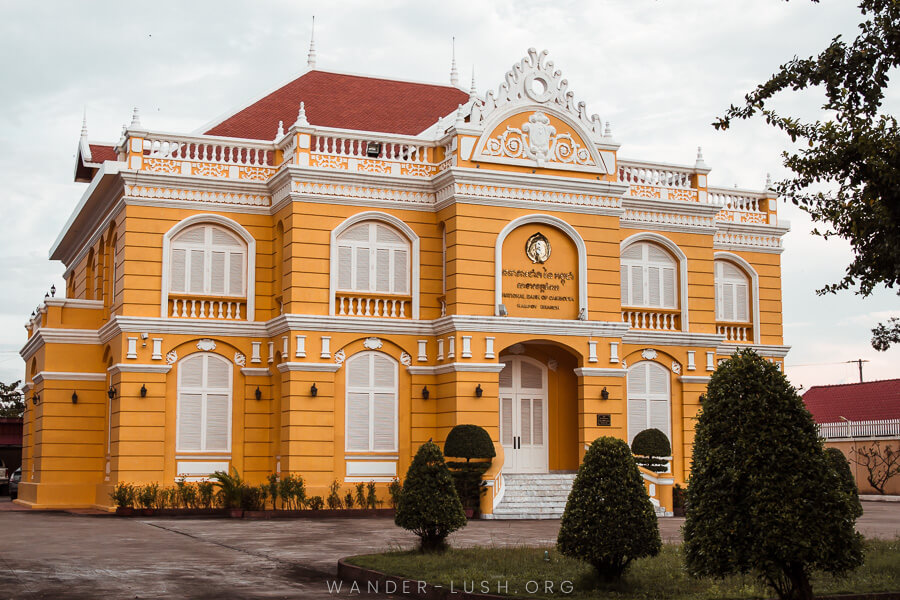
Admire Kampot’s colonial architecture
As in Battambang and Phnom Penh, Kampot’s French government poured squillions into bestowing their regional capital with exquisite architectural landmarks. Kampot’s most impressive colonial buildings are located along the river south of the Old Market area. The National Bank of Cambodia, the Kampot Provincial Museum, and the brick-coloured Red Cross Kampot Branch have all been authentically restored.
During the Pol Pot era, the Khmer Rouge abolished currency and blew up the National Bank in Phnom Penh. Luckily, the Kampot branch didn’t meet a similar fate. The bank building has been completely rehabilitated, manicured hedges and all. It’s still used as a government building so you can’t go inside, but security guards stationed out front are happy for you to take photos through the fence or the open gate. Come after 5pm when the bank closes to get a snap without cars parked out front.
Learn about local history at the Kampot Provincial Museum
I must admit I was very skeptical of visiting the Kampot Provincial Museum. It took me four trips to Kampot before I decided to give it a go – but I’m so glad I did! Displays are a bit dated and the museum is pretty sparse overall, but it’s worth the cheap ticket price (adults pay $2) just to see the interior of the building.
Located south of the Old Market on the edge of the river, the museum is set inside the Old Governor’s Mansion. Like the National Bank next door, it has been beautifully restored, its plasterwork, heritage floor tiles and wooden shutters all brought back from the brink. Downstairs, anyway. Upstairs, the house is completely deserted – just a set of dusty old rooms. Staff don’t seem to mind if you wander around.
There is a fair amount of information in English. The most interesting exhibits detail Kampot’s colonial history and former residents. If you’re serious about your architecture, this is the place to learn more about civic projects including the Old Bridge and the Fish Market.

Walk a lap around the Lotus Pond
Behind the Museum you’ll find an almost perfectly round lake with a shrine in the middle and a pagoda set on its edge. The Lotus Pond is a popular spot among locals for a dusk-time stroll. When I last visited, the poor lotuses that blanket the water had all but dried up as a result of the unseasonably hot weather.
Even if the flowers aren’t in bloom, there’s still a feeling of tranquility and reverence about the place.
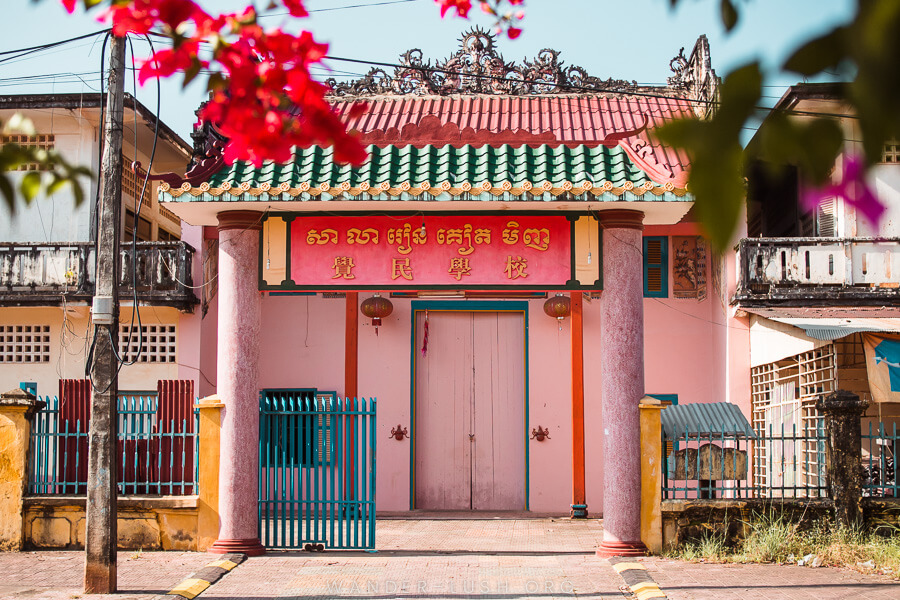
Photograph the Chinese School
Kampot is best-known for its French colonial buildings. In reality, there are lots of different architectural styles that combine to give the city its unique character. Jue Ming Chinese School is probably my favourite building in town. Kampot has long been home to a prominent Chinese community, and the School speaks to their place in society. It’s still in use today – although I didn’t go inside the last time I was there.
Painted pink and with an ornate coin roof, it’s impossible to miss as you walk inland from the Lotus Pond towards the Saltworkers Roundabout.

Discover contemporary artists at the Kampot Art Gallery
Update: As of December 2020, Kampot Art Gallery has relocated to Phnom Penh and is now known as PiPetPi Gallery 282.
Managed by Australian collector Liz, Kampot Art Gallery is devoted to showcasing local Khmer artists. Contemporary photography, canvases and sculptures by creatives from Kampot, Battambang and other parts of the country are displayed in two breezy upstairs galleries. There’s also a rotating program of special exhibitions.
Downstairs, you’ll find a gift shop selling papergoods and upcycled jewellery.

Pick up a novel from Bookish Bazaar
If you need to replenish your holiday reading materials, Bookish Bazaar just off the Old Market sells a great selection of novels, non-fiction volumes and guide books. Most offerings are pre-loved and go for very reasonable prices. If you have a book you want to offload, you can bring it in to swap or sell.
Upstairs reading nooks and the downstairs cafe are perfect places to curl up with a book on a rainy Kampot day.

Shop for ethical fashion at Dorsu
Lightweight fabrics and relaxed fits – Dorsu has found a way to encapsulate Kampot’s laid-back attitude in fashion form. The ethical women’s and menswear label was founded by Australian Hanna Guy and local entrepreneurs Pharith Yin and Kunthear Mov back in 2008.
It started as a project to raise funds for the nearby Chumkriel Language School, and has since grown into a successful sewing workshop that offers fair wages and up-skilling opportunities to Cambodian women and men. All the materials used in Dorsu’s collections are fabric remnants sourced from the big garment factories outside of Phnom Penh.
Dorsu has two stores in Kampot, one on Old Market Street and another shop/workshop next door to Cafe Espresso. They also have a new shop in Phnom Penh’s Russian Market.
Update 2020: Sadly, Dorsu has closed the doors of its brick-and-mortar shop in Kampot. Shop online instead or visit their branch in Phnom Penh.

Rummage through Khmer collectables at Kampothead
Set in Kampot’s Old Royal Cinema, complete with original floor tiles and imposing concrete facade, Kampothead is a window onto Cambodia’s past.
The petite knickknack shop peddles an oddball edit of vintage and antique wares sourced from the Kingdom and all over Asia. In a backpacker and expat-heavy town where a strong ‘hippy’ aesthetic has taken root – set in a country where there’s seemingly little regard for anything that’s not new and shiny – Khmer-owned Kampothead couldn’t be more perfect.

Twirling around the shop floor in a 1960s sundress, owner Sutee curates Kampothead’s crowded shelves, but it was her husband – an artist and designer – who first sourced the knickknacks. Overwhelmed by the collection he had accrued through years of travel, the couple opened Kampothead to try and lighten their load.

The store’s centrepiece, an ancient electrical switchboard from Hong Kong, frames the front counter, where relics of Cambodia’s dancehall days intermingle with other Asian curiosities. Some items are decaying and in need of repair – just like Kampot itself – while other collectables are in remarkably good shape.
Among them are dainty Japanese ceramics, winged creatures set in resin, Indian woodblocks, balm tins etched with curvy Khmer script, family photographs from old Saigon, French linen shirts, cigar boxes, old hand-painted shop signage… The list goes on. Items are well priced and Sutee will always cut you a good deal.
Outdoor activities & adventurous things to do in Kampot
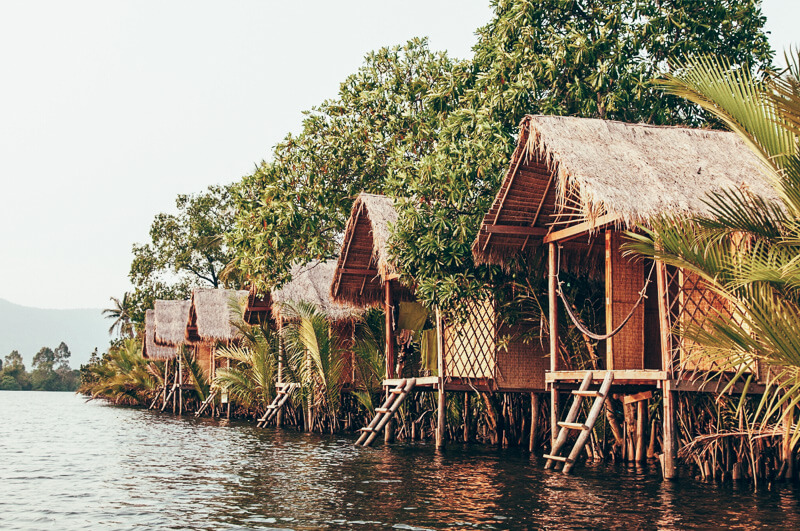
Kayak the ‘Green Cathedral’
The most idyllic stretch of Praek Tuek Chhu river lies 5km north of Kampot city, where the waterway naturally curves to accommodate thickets of jungle foliage and mangrove swamps. The Green Cathedral is a lush still-water loop where you can gently paddle a kayak.
Most lodges on the river hire out kayaks and life jackets to non-guests for a small fee. It’s a good idea to call in advance if you’re travelling during high season. We usually use the gear at Champa Lodge, where prices start from $3/hour.
Before you set out, ask staff to point you towards the river loop. It’s an easy paddle down gentle currents that takes about 1.5 hours to complete. The corridor of palm trees that lines the riverbank widens and contracts with each bend, and shallow rivulets trail off in every direction, leading to crab pots, lone fishermen and sinking shacks. The backwaters are mostly shaded, but remember to dress sensibly if you’re out during the day.

Motorbike in Bokor National Park
Preah Monivong Bokor National Park lies 37km west of Kampot Old Market. At an elevation of 1km, it was originally established as a French hill station where people could go to relax and escape the heat (similar to Dalat in Vietnam).
Bokor is the perfect place for a DIY motorbike adventure. If you don’t ride, you can hire a taxi or tuk tuk for the day to take you up and around. This post provides detailed information about visiting Bokor National Park.

Go urbexing
Bokor boasts magnificent flora and fauna (including an elusive population of wild gibbons and sunbears), but it’s the park’s man-made structures that are most iconic. Hotels, private villas, Catholic churches and a grand casino built by the French and long abandoned dot the landscape. The ridge is perpetually shrouded in mist, adding to the ghostly feel.
Some of the buildings have been repurposed, but it’s possible to go inside many of the abandoned, derelict structures.

Join a Kampot pepper tour
Kampot peppercorns are known the world over for their superior taste. It’s thought that pepper trees were first introduced to the area by the Sultan of Aceh, who sought to protect his precious crops from the Dutch when they colonised Indonesia. Pepper has been commercially cultivated in Kampot as far back as the 13th century. By the 1920s, almost all pepper consumed in France – an estimated 2,600 tonnes – came from this part of Cambodia!
Almost all of the country’s pepper trees (and cacao trees) were destroyed in the 1970s to make way for cooperative rice farms. In recent decades, the industry has experienced a resurgence, and now pepper farming is once again a profitable business.
Green, black and yellow pepper is grown and milled in plantations around the city. Popular farms including La Plantation and Khmer-French Farmlink offer free guided tours, where you can see the pepper trees and learn all about the harvesting process.

Visit the Kampot salt fields
Along with pepper, Kampot is also known as a producer of fine sea salt. Vast salt pans line the lip of the river on the outskirts of town, edged with huge warehouses used for storing equipment and keeping harvested salt away from the elements. At the right time of year, you can watch salt workers raking the fields for crystals. Note that the fields are usually empty on Sundays.
The easiest way to explore the salt fields is by bicycle. From the Old Market, take the river road south until you see Kampong Treak Mosque. The salt flats are located inland from there.

Cycle through the rice fields
Any piece of empty land that’s not being used for salt or pepper is planted out with rice. Kampot’s rice fields are particularly pretty because they’re ringed with towering palm trees. The best time to see the rice fields is at the end of the wet season or at harvest time.
The photo above was taken during ‘transplant’ season, when farmers take last year’s clippings and re-plant them in the ankle-deep, shimmering water.

Explore Kampot’s cave temples
Phnom Chhngok Cave Temple is a 7th Century Hindu shrine set in a limestone cave on the outskirts of Kampot. When you arrive at the site via a bumpy rode, you need to continue walking or cycling through farmland to reach the cliffs where the caves are hidden. There’s no official entry fee, but you might be charged a few dollars to enter. The cave is well lit.
Get high with Climbodia
If tight spaces are your thing, Climbodia offers caving and climbing guided tours for all levels, from beginner to advanced. The four-hour Discovery Tour combines easy rock climbing, abseiling and caving to introduce you to the area’s curious rock formations.
Tours depart daily from the Climbodia office in town. Safety gear is provided, but advanced bookings – and sturdy shoes – are essential.

Track down Kampot’s secret lake & waterfall
Brateak Krola Lake, AKA Kampot’s ‘secret lake’, might not be such a secret now that it’s pinned on Google Maps. It’s still a lovely place to chill out in the afternoon, especially if you hit up one of cafes on the edge of the water. Khmer Root Cafe, open daily from 11am-5pm, serves wholesome veg-based cuisine in a rustic bungalow overlooking the lake.
The exact location of Kampot’s secret waterfall still remains something of a mystery. If you have your own motorbike and you’re up for a bit of adventure, ask around and try to track it down.
Go SUP or kite boarding
If kayaking is too milquetoast, SUP Asia offers stand up paddleboarding tours and equipment hire in Kampot and on the Mekong in Kratie. Group tours that take you through Kampot and Kep depart twice daily from their office in town. If you opt for a customised tour, you can SUP at sunset – or even try your hand at SUP yoga.
Relaxing things to do in Kampot
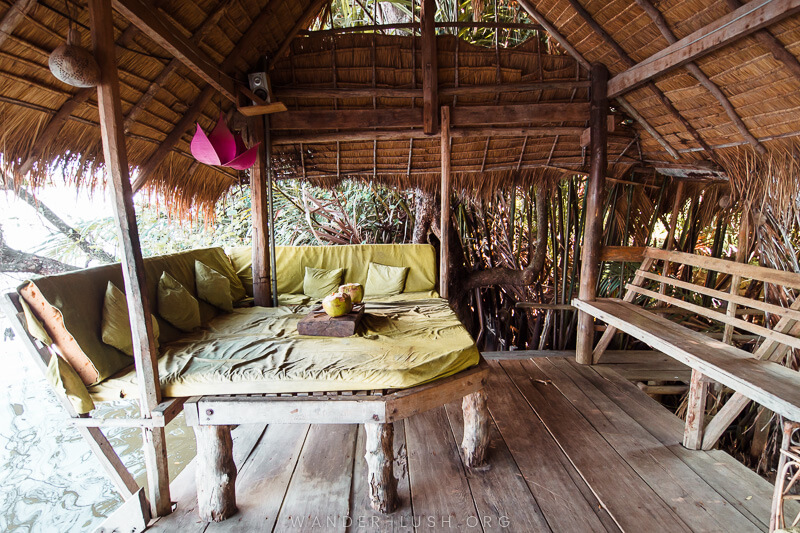
Kick back on the Kampot riverside
You don’t need to be out on the water to enjoy Kampot’s river vibes. Champa Lodge, Greenhouse and most other resorts on the northern part of riverside welcome drop-ins to have a drink or just chill in their gardens. It’s safe to swim in the water, although I personally choose not to. Currents can get very strong in the wet season, so take extra care and avoid swimming at night or if you’ve had a few too many drinks.
Banteay Srey Project on the oppsite side of the Old Bridge has a lovely lounging area where you can enjoy vegan food and fresh juices. They even provide Khmer-style swimmers for free if you forgot yours. Note that Banteay Srey is a women’s only space (more in the next section).
Have a massage at Banteay Srey Spa
Banteay Srey Project was founded as a vocational training center for disadvantaged Cambodian women. The Project runs three social enterprises in Kampot – a women’s spa, a yoga studio, and a vegan cafe.
The setting – a traditional wooden house up river from the Old Bridge, right on the river – is really stunning. Massages and beauty treatments are performed en plein air on the house’s veranda. Although I personally didn’t love the back and neck massage I ordered, I really enjoyed relaxing in the bungalow.

Go cruising with Love the River
If laying down the paddles and lying back under the shade of a parasol sounds more like your thing, Love the River offers private trips through the Green Cathedral and beyond in a traditional wooden longtail boat. Tours last 3 hours, and include time to disembark for a swim and a short walk around a fruit plantation.
Boats leave in the early morning (from 6am) and again after 5pm for sunset from the jetty at Greenhouse. Advance bookings by phone are required.
Foodie things to do in Kampot
Join a cooking class at La Plantation
The only thing better than seeing how Kampot pepper is harvested is learning how to use it to make a stir fry – or better yet, Kampot pepper crab. La Plantation Pepper Farm hosts 3-hour cooking masterclasses with resident kitchen whizz, Chef Wantho. Starting from $20 per person including lunch, it’s incredibly good value.
Eat Authentic Italian at Ciao
It’s an unlikely contender, but Ciao might just be my favourite restaurant in Cambodia. Chef Diego, an expatriate from Pescara, runs the kitchen with his partner and sometimes his mum when she’s over from Italy. Paper-thin pizzas (fired in a tiny wood oven), tagliatelle (made from scratch using a WWII-era pasta machine) and gnocchi all come sparingly dressed with fresh, local ingredients. The homemade meatballs are the best I’ve ever tasted, and the two-cheese pasta with Kampot pepper is otherworldly.
Ciao used to occupy a tarpaulin-covered stall on Street 277 near the Old Market, but it’s since relocated to the balcony of Diego’s house on Newport Street (roughly a 15-minute drive from town). If you take a tuk tuk over, ask the driver to come back for you – otherwise Diego can help to order you a ride back on PassApp. He serves lunch daily and dinner every night except Thursday. If it’s quiet, they might even invite you to eat with them – which is what happened to me last time I visited!
Diego often runs out of pizza dough or pasta (or both) mid-service, so plan to arrive early. Ciao is both tiny and very popular with expats (especially on Saturdays), so expect to wait a while for your meal. Cash only.
Sip Kampot’s best coffee at Cafe Espresso Roastery
Australian-owned Cafe Espresso is Kampot’s trendiest eatery. Bright, airy and filled with gorgeous artwork, it’s all about the coffee: espresso, pour-overs, Aeropress, siphons and for simpletons like me, on-point flat whites. Locally grown coffee beans are roasted in-house daily (under the label Rumble Fish), and if you love it as much as I did, you can take a packet home with you.
Come hungry, because the food is exceptional. Cafe Espresso does a great job of highlighting local ingredients, including Kampot sea salt which is added to their house-made caramel. Try it stirred through an old-fashioned milkshake or doused liberally over fluffy pancakes. Cafe-style savory meals – I love the Kampot eggs benny – also come with Kampot salt and pepper on the side.
Related: Where to find the best cup of coffee in Phnom Penh.
Brunch for a cause at Epic Arts
Epic Arts is a Kampot mainstay and one of the most popular cafes in the Old Market area. A social enterprise, the eatery generates funds for arts-based therapy programs for Cambodian adults and kids. Staff employed at the cafe are hearing impaired – they’ve come up with some inventive ways to ensure smooth communication. The food and coffee are great, and service is always with a smile. Eating here is a really special experience.
Satisfy your sweet tooth at Nom Tom Bakery
New on the Kampot food scene, Nom Tom is a roving bakery run by Belgian expats. The bakery truck parks on the riverside opposite Vanna’s Restaurant from Tuesday to Saturday, selling artisanal bread, sweet pastries and buttery croissants from 7am until they run out (which doesn’t take very long).
Related: The best bakeries & brunch cafes for breakfast in Phnom Penh.
Quench your thirst at Kampot Juice Box
This side-of-the-road juice shack at the top of the Old Market boasts an inventive menu of fresh fruit juices and smoothies (mango and turmeric is my personal favourite). I love that everything is blended fresh to order, and if you drink in, served in a glass with a bamboo straw to cut back on plastic waste.

Taste Kampot’s international flavour
Along with Chef Diego at Ciao, dozens of other expats have set up restaurants and cafes in Kampot over the years. Portuguese, Mexican, Israeli, British and French are just some of the international cuisines on offer. The food scene in Kampot is really outstanding – you can’t really go wrong whatever you choose.
My favourite restaurant in town is Twenty Three, which specialises in modern European made with seasonal ingredients.
Try a Kampot Cider
Kampot’s own brand of cider is fizzy and mellow, and it’s best served over ice. The Rusty Keyhole is one of the more popular drinking holes in town, with good views over the river and a pleasant afternoon breeze.
Drink beer & eat sushi at Kampot’s first nanobrewery
Beer and sushi might seem like a strange combination, but at Japanese-run Flowers Nanobrewery, it’s all the rave. Pair a house-brewed lemongrass pale ale with a freshly rolled salmon and cream cheese or a plate of steaming pork dumplings.
Flowers is only open on weekends from 3.30pm and has a limited number of tables, so it’s recommended to arrive early. If you’re visiting during the week, you can still try Flowers beer at Twenty Three and a handful of other venues around town.
Things to do in Kampot at night

Soak up an unmissable Kampot sunset
As the gently serrated horizon swallows up the afternoon sun, distant palm trees turn into shards of shadow and the rippling river carries glittering rays across its surface. Yes, Kampot at dusk really is that good.
The jungle-clad part of the river north of Kampot town is by far the best place to watch the sun go down, and this is where most tourists flock come 6pm. Kayaking from Champa Lodge, an ideal sunset vantage point can easily be reached by following the river to the right. (This is the same spot where one of the sunset cruise boats stops.)
Plan to hit the water at around 5pm – if you don’t have a watch, you can tell the time by the fishing trawlers that set off every evening at dusk like clockwork. Once you’ve paddled the river loop, you should be perfectly timed to float back into the main lagoon for a textbook sunset.

Cocktails on the balcony at Rikitikitavi
The high-set timber balcony at boutique hotel Rikitikitavi is a pleasant place to watch the sun go down on another perfect Kampot day. Set yourself up at the front bar for the best views. Kampot Fish Market, down on the water below, also has a great vantage point from the back deck.

Grab a cheap bite at the Kampot Night Market
Kampot Night Market is open daily from mid-morning, but it really kicks off at about 5pm. Local families and couples flock here to shop, ride the slightly bizaare amusement park rides, and eat street-style Khmer food. If you’re travelling on a budget, this is the best place to pick up a cheap, quick meal.
The best day trips from Kampot
Day trip to Kep beach
Kep is a small beachside town on the coast about 25km (or 40 minutes’ drive) southeast of Kampot. A tuk tuk from Kampot to Kep will cost you between 7 and 10 USD one-way. If you want to take the scenic route, board the Crab Shuttle, a wooden boat that leaves Kampot at 9am daily and arrives in Kep at 11.20am. Tickets cost $10 one-way or $13.50 return (the boat leaves Kep at 3pm).

Start your day in at Kep Coffee, an unassuming little cafe hidden in the brush near Koh Tonsay jetty on the eastern side of town. The omelettes, sandwiches and homemade cakes are all delicious.
Round the peninsular to Kep beach, passing the town’s famous crab statue on the way. Here you’ll find hammocks and beach chairs for hire, coconut vendors and a stretch of beautiful white sand.
Kep’s crab market is the city’s main draw. The best way to experience it is by first walking through the line of restaurants that crowd the road. When you hit the low-strung tarpaulins, you’ve entered the market. Head right to the back and the market backs onto the sea and a working jetty, where you can see the crab traps being hauled and set.

Kep Sailing Club is a beautiful spot for lunch. It’s pricey (and definitely more expensive than eating at one of the crab shacks), but its worth it for the beautiful decor and ocean views.

Day trip to Rabbit Island
Koh Tonsay (Rabbit Island) sits just off the coast of Kep. It boasts a beautiful stretch of beach and a few rustic bungalows.
If you’re taking the Crab Shuttle from Kampot, the captain can make arrangements for you to transfer straight to another boat bound for the island. If not, make your own way to the pier and take one of the local boats that depart at 9am and 1pm ($8 return) or charter a private boat (approx. $25 return).
Day trip to Bokor National Park
Here’s everything you need to know about organising a DIY trip to Bokor, or joining a Bokor National Park tour.
Map of things to do in Kampot
Click to open the interactive map in Google Maps.

6 things to pack for Kampot
- Swimming kit. Pack togs and a quick-dry towel if you plan on swimming in the river or partaking in any river sports. A long-sleeved rashie (sun shirt) is also a good idea if you have sensitive skin.
- A reusable water bottle. Absolutely essential in Cambodia for minimising plastic waste and staying hydrated. I love my S’Well water bottle – it’s vacuum insulated to keep water icy cold for the whole day, and it doesn’t sweat. If you like your mango smoothies, pack a reusable smoothie cup as well.
- Rehydration tablets or sachets. At the end of a long day bike riding or exploring temples, your body will be crying out for electrolytes (believe me!). I prefer Hydralyte tablets because they come in a handy tube. If you forget to bring some from home, the Double D brand is sold at most pharmacies and grocery stores in Cambodia.
- Rain jacket and travel umbrella for the wet season. Wet season is my favourite time to travel in Cambodia because the countryside is so verdant. Downpours come out of nowhere, so it’s essential to have a rain jacket with you at all times (I love the packable rain jackets by Lomon for women and EZRUN for men). I also carry a travel umbrella in case it’s too hot and steamy to wear a jacket. This one is UPF 50+, making it great for sun cover as well.
- A sturdy day pack. An anti-theft backpack is particularly good for using in Cambodian cities. Opt for a minimalist backpack that doesn’t stand out.
- Cambodia guide book. I prefer Lonely Planet’s dedicated Cambodia guidebook or regional guidebook that also covers Laos, Vietnam and Northern Thailand.
More Cambodia travel resources
- Where to stay in Kampot – Complete Kampot accommodation guide
- Getting around in Cambodia – How to use PassApp to book a tuk tuk
- 51 Free things to do in Phnom Penh
- Phnom Penh accommodation guide – The best Phnom Penh hotels
- Resort style swimming pools in Phnom Penh
- The best restaurants in Phnom Penh
- My guide to Kampong Cham, Cambodia’s most charming town
- Where to stay in Siem Reap
- The best tours in Siem Reap – A comprehensive guide
What are your favourite things to do in Kampot? Have a question about Kampot travel or another destination in Cambodia? Leave your comments below.

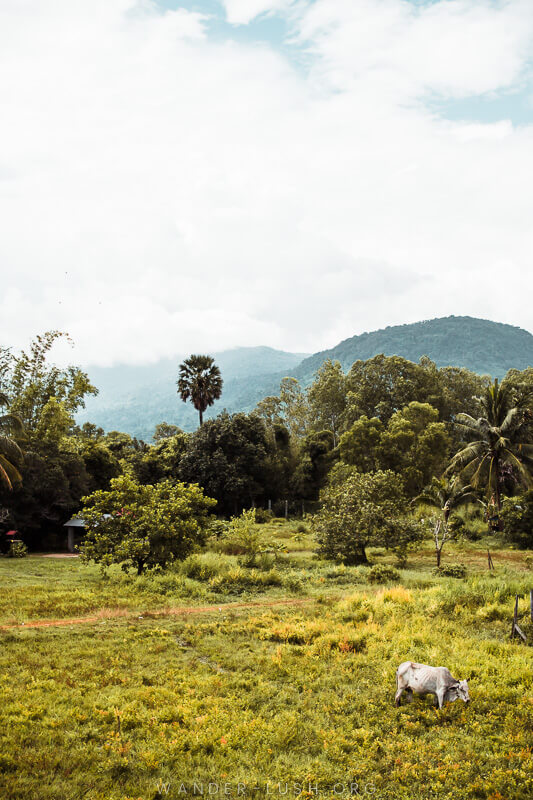












Dear Emily, thank you soooo very much for website/suggestions we always consult it wherever possible (so far for Georgia, Armenia, Oman and Cambodia).
We just returned from Cambodia (PP, Siem Reap and Kampot). Kampot is cute, and the highlight was to stay at the Old Cinema Hotel, thank you, its such a gem!!! extra bonus Le Cafe Kampot, 1min down the road from the hotel does good coffee and frappès.
Wanted to share some info too, re pepper plantations we went to “Sindora, Garden of Pepper” and had a delicious lunch there with 100% their produce. The owners are lovely and apart from selling pepper/various ayuvedic spice combos, they are involved in a reforestation project of their land. A very nobile cause indeed. On the way back into Kampot we popped into La Plantation, beautiful property but to be honest it is too much of a large scale “factory” business / too touristy and impersonal for my liking. Would have loved to pop by BoTree plantation too (unfortunately didn’t have enough time), their peppers have won several awards, and it is a family run farm. Next time.
Also :
-the former fish market is now a Starbucks but the building is still very beautiful.
– the Kampot Provincial Museum is permanently closed
– KHMER COLLECTABLES AT KAMPOTHEAD in the Old Royal Cinema also closed. (I mentioned it to the lady at the Old Cinema Hotel and she said that perhaps it could become the next/2nd project – fingers crossed, as its currently all boarded up, so sad)
– we did a fun cooking course with Sophia at “Lucky Kitchen Cooking Class” (on TripAdvisor) on her rooftop a short distance from the center. She used to have a restaurant in Sihanoukville until it become super touristy/expensive.
– the lady with the croissants/various pastries truck is still around and going strong, in front of Vanna’s restaurant (also worth popping in for some Khmer dishes) beside the river.
Thanks so much Nancy for the updates, this is extremely helpful. So glad you got to stay at Old Cinema! I will be returning there when I visit Cambodia at the end of this year!
That’s great compilation! You can also go to stay at Pippali Hotel in Kampot, one of greatest escape for your stay.
Emily nice fantasy article about Kampot. Maybe a while since you’ve been. Not painting a true picture for people. Kampot is nice enough. A bit dirty, smelly, lot of poor looking old guys plus young girl couples, dregs of western society living here. Old dilapidated building have some charm sure, river brown water n trashy, no way clean to swim in. Need to update your blog.
Hi Ewan – I was last in Kampot at the end of 2019. I can’t imagine it’s changed that much – I hope not!
The river is much cleaner upstream around the Green Cathedral and this is where I suggest swimming.
Kampot has won awards for being one of the cleanest cities in Cambodia. My experience living/travelling in the country for more than 12 months confirms that. Yes there is a seedy side of course, but it’s nothing compared to Sihanoukville or Koh Kong. Each to their own, but I love Kampot and everything I’ve written here is true and accurate to the best of my knowledge.
Kudos to a really informative post with great photos. Especially love the photo of the Fish Market. May we use it with a teaser and link to this article?
Please email me for image requests, thanks!
I loved my time in Kampot. There were so many eco-projects and vegetarian and vegan food options. Beautiful small town.
Absolutely! Glad you enjoyed your visit to Kampot as much as I did.
What a great list.. well done!!
Don’t forget the wonderful Live Music scene in Kampot too:
Karma Traders rooftop bar hosts live music events every single Tuesday since 2016 and is popular amongst expats and tourists.
Infamata Bar have weekly gigs and the Rhymes on the River boat operates every Thursday during high season too. Other venues include The Plantation, Samurai Saloon, Levels and Banyan Tree. Great music scene!
Thanks Matt, great tips!
Alll perfect recs! Update: Dorsu moved next door to espresso cafe and ciao moved out of the city center. It’s a bit difficult to get to, but still delicious!
Thanks so much for the update, Joanne! A friend just ate at Ciao and mentioned it had moved. I’ll be updating this post soon so I’ll be sure to include those details.
Glad to hear it’s still delish! I think of my dinners there often!!
So great – love your posts!
Thanks so much, Ashley! You have a beautiful website and I so admire your work! Hope you can partner with artisans in Cambodia one day.